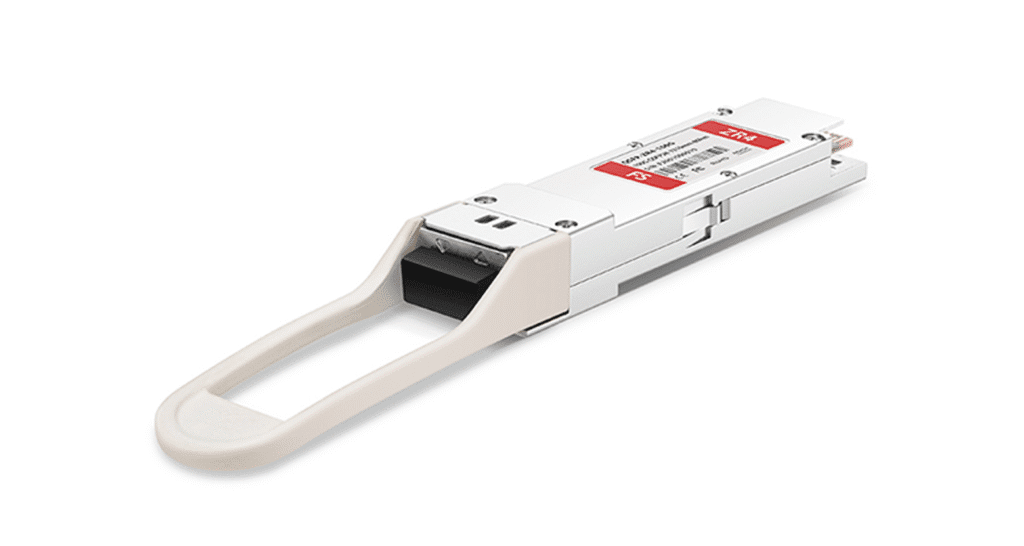As network infrastructure expands to meet the demands of cloud computing, edge data centers, and global interconnectivity, long-distance, high-bandwidth communication becomes critical. Among the optical transceiver solutions available for 100 Gigabit Ethernet, the 100GBASE-ZR4 module plays a vital role in bridging these geographical and operational gaps. Designed to operate over single-mode fiber and capable of supporting transmission distances up to 80 kilometers, 100GBASE-ZR4 is not just a powerful tool—it’s a necessity for service providers, cloud platforms, and large enterprises alike.
What is 100GBASE-ZR4?
100GBASE-ZR4 is a long-reach optical transceiver designed for 100G Ethernet connections over single-mode fiber (SMF). It uses four lanes of coarse wavelength-division multiplexing (CWDM) in the 1310 nm range, allowing it to send and receive data across significant distances—typically up to 80 km—without the need for inline optical amplification. The module adheres to standards such as the CWDM4 MSA or proprietary specifications that extend its capabilities. It is commonly housed in a QSFP28 form factor, making it compatible with a wide range of switches, routers, and network interface devices.
ZR4 modules typically use duplex LC connectors and are fully interoperable with other modules that support the same wavelength scheme and optical power budget. In practical deployments, they often eliminate the need for additional infrastructure like dispersion compensation modules or optical repeaters, which simplifies installation and reduces total cost of ownership. With built-in digital diagnostics monitoring (DDM), network administrators can also keep a close eye on parameters such as temperature, voltage, and optical power levels.
Application Scenarios for ZR4
The primary application of 100GBASE-ZR4 lies in environments where long-distance point-to-point links are required. One of the most common use cases is data center interconnect (DCI)—the need to connect geographically separated data centers with high-bandwidth links. ZR4 modules allow operators to create seamless, high-speed connections between facilities without relying on third-party transport services or building custom optical transport solutions.
Additionally, 100GBASE-ZR4 is widely deployed in carrier and metro networks, where telecommunications providers need to transmit large volumes of data across cities or regions. In these environments, the ability to span tens of kilometers with minimal signal degradation is critical. Beyond traditional telecom, large enterprises with campus-style infrastructure or multiple office buildings often use ZR4 for backbone connectivity, enabling them to centralize IT resources while maintaining ultra-fast links across locations. Its ease of deployment and compliance with existing 100G Ethernet standards make it an attractive solution for many forward-looking organizations.
Advantages and Limitations
One of the most significant advantages of 100GBASE-ZR4 is its ability to deliver high-speed connections over extended distances using a relatively simple optical interface. Unlike more complex coherent solutions that require additional DSP (digital signal processing) or external optical amplifiers, ZR4 modules offer a plug-and-play solution within the Ethernet ecosystem. This lowers the barrier to entry for organizations looking to scale their networks without diving into the complexities of traditional DWDM systems.
However, this module is not without its limitations. Its longer reach comes at a higher cost when compared to short-reach modules like 100GBASE-SR4 or LR4. In addition, although ZR4 supports up to 80 km, actual performance may vary depending on fiber quality, insertion losses, and the presence of fiber connectors or splices. There’s also the matter of power consumption, which is higher than shorter-range modules due to the need for more powerful lasers and signal conditioning circuitry. Still, the total cost and power budget are generally lower than alternative long-haul technologies, especially for medium-range distances.
The Road Ahead for ZR4 Modules
As networking needs evolve, 100GBASE-ZR4 modules are expected to see sustained and growing demand. While the rise of 400G and 800G transceivers is gaining momentum in hyper-scale environments, 100G remains the foundational speed for a large portion of enterprise and carrier networks. ZR4 modules are particularly well-positioned to support hybrid infrastructures where not all sites are upgraded to higher capacities at once. They offer a stable and compatible stepping stone between legacy infrastructure and the next generation of networking hardware.
Looking forward, advances in silicon photonics and module miniaturization may improve the performance and affordability of ZR4 modules even further. Vendors are also beginning to release variants with enhanced performance—such as tunable wavelength options or extended temperature ranges—to cater to more demanding deployments. The flexibility, reach, and standard compliance of ZR4 ensure it will continue to be a cornerstone of long-distance Ethernet connectivity in the foreseeable future.
Conclusion
In today’s interconnected digital ecosystem, the 100GBASE-ZR4 module offers a compelling solution for long-distance, high-bandwidth optical links. Its ability to deliver 100G Ethernet over up to 80 kilometers of single-mode fiber makes it ideal for data center interconnects, metro transport, and large enterprise backbones. While it carries a higher cost and power footprint than short-reach modules, its simplicity and reach make it a cost-effective choice for bridging critical infrastructure. As innovation drives down costs and expands capabilities, ZR4 is set to remain a key player in the evolution of Ethernet networking.



